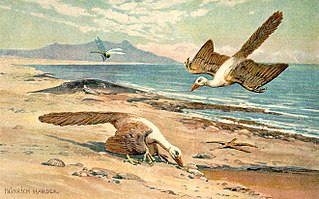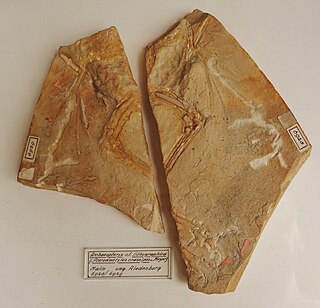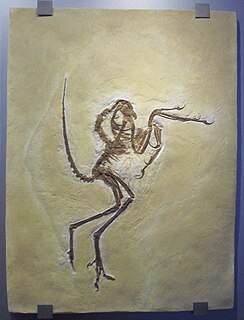 W
WThe scientific question of within which larger group of animals birds evolved has traditionally been called the 'origin of birds'. The present scientific consensus is that birds are a group of maniraptoran theropod dinosaurs that originated during the Mesozoic Era.
 W
WAlcmonavis is a basal genus of avialan dinosaur that during the Late Jurassic lived in the area of present Germany. The only named species in the genus is Alcmonavis poeschli. Its only known fossil was originally reported as a specimen of Archaeopteryx.
 W
WAnchiornis is a genus of small, four-winged paravian dinosaur. The genus Anchiornis contains only the type species Anchiornis huxleyi, named for its similarity to modern birds. Anchiornis fossils have been only found in the Tiaojishan Formation of Liaoning, China, in rocks dated to the Late Jurassic, about 160 million years ago. Anchiornis is known from hundreds of specimens, and given the exquisite preservation of some of these fossils, it became the first Mesozoic dinosaur species for which almost the entire life appearance could be determined, and an important source of information on the early evolution of birds. Anchiornis huxleyi translates to "Huxley's near-bird" in Greek.
 W
WArchaeopteryx, sometimes referred to by its German name, Urvogel, is a genus of bird-like dinosaurs. The name derives from the ancient Greek ἀρχαῖος (archaīos), meaning "ancient", and πτέρυξ (ptéryx), meaning "feather" or "wing". Between the late 19th century and the early 21st century, Archaeopteryx was generally accepted by palaeontologists and popular reference books as the oldest known bird. Older potential avialans have since been identified, including Anchiornis, Xiaotingia, and Aurornis.
 W
WThe Archaeornithes, classically Archæornithes, is an extinct group of the first primitive, reptile-like birds. It is an evolutionary grade of transitional fossils, the primitive birds halfway between non avian dinosaur ancestors and the derived modern birds.
 W
WAurornis is an extinct genus of anchiornithid theropod dinosaurs from the Jurassic period of China. The genus Aurornis contains a single known species, Aurornis xui. Aurornis xui may be the most basal ("primitive") avialan dinosaur known to date, and it is one of the earliest avialans found to date. The fossil evidence for the animal pre-dates that of Archaeopteryx lithographica, often considered the earliest bird species, by about 10 million years.
 W
WCaihong is a genus of small paravian theropod dinosaur from China that lived during the Late Jurassic period.
 W
WEosinopteryx is an extinct genus of theropod dinosaurs known the late Jurassic period of China. It contains a single species, Eosinopteryx brevipenna.
 W
WManiraptora is a clade of coelurosaurian dinosaurs which includes the birds and the non-avian dinosaurs that were more closely related to them than to Ornithomimus velox. It contains the major subgroups Avialae, Deinonychosauria, Oviraptorosauria and Therizinosauria. Ornitholestes and the Alvarezsauroidea are also often included. Together with the next closest sister group, the Ornithomimosauria, Maniraptora comprises the more inclusive clade Maniraptoriformes. Maniraptorans first appear in the fossil record during the Jurassic Period, and are regarded as surviving today as living birds.
 W
WOstromia is a genus of anchiornithid theropod dinosaur from the Late Jurassic Painten Formation of Germany. The genus contains a single species, O. crassipes, named by Christian Foth and Oliver Rauhut in 2017.
 W
WParaves are a widespread group of theropod dinosaurs that originated in the Late Jurassic period. In addition to the extinct dromaeosaurids, troodontids, anchiornithids, and scansoriopterygids, the group also contains the avialans, among which are the over ten thousand species of living birds. Primitive members of Paraves are well known for the possession of an enlarged claw on the second digit of the foot, which was held off the ground when walking in some species.
 W
WPennaraptora is a clade defined as the most recent common ancestor of Oviraptor philoceratops, Deinonychus antirrhopus, and Passer domesticus, and all descendants thereof, by Foth et al., 2014.
 W
WPraeornis is a dubious genus of early avialan or bird-like dinosaur, named on the basis of a single feather discovered in the Karabastau Formation of Kazakhstan by Sharov in 1971. A second specimen was discovered in 2010 by Dzik et al. The feathers of Praeornis likely represent modified tail feathers used for display or balance, similar to those found in some other early avialans. The feathers of Praeornis are unique thanks to their extremely thick central quill (rachis) and stiffened barbs.
 W
WSerikornis is a genus of small, feathered anchiornithid dinosaur from the Upper Jurassic Tiaojishan Formation of Liaoning, China. It is represented by the type species Serikornis sungei.
 W
WWellnhoferia is a genus of early prehistoric bird-like theropod dinosaur closely related to Archaeopteryx. It lived in what is now Germany, during the Late Jurassic. While Wellnhoferia was similar to Archaeopteryx, it had a shorter tail and its fourth toe was shorter than in Archaeopteryx. Andrzej Elżanowski (2001) of the Institute of Zoology of the University of Wrocław, Poland, determined the differences resulted from a "phylogenetic reduction rather than individual variation."
 W
WXiaotingia is a genus of anchiornithid theropod dinosaur from early Late Jurassic deposits of western Liaoning, China, containing a single species, Xiaotingia zhengi.